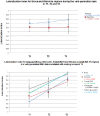Greater Utilization of Neural-Circuits Related to Executive Functions is Associated with Better Reading: A Longitudinal fMRI Study Using the Verb Generation Task
- PMID: 24999322
- PMCID: PMC4064667
- DOI: 10.3389/fnhum.2014.00447
Greater Utilization of Neural-Circuits Related to Executive Functions is Associated with Better Reading: A Longitudinal fMRI Study Using the Verb Generation Task
Abstract
Introduction: Reading is an acquired-developmental ability that relies on intact language and executive function skills. Verbal fluency tasks (such as verb generation) also engage language and executive function skills. Performance of such tasks matures with normal language development, and is independent of reading proficiency. In this longitudinal fMRI study, we aim to examine the association between maturation of neural-circuits supporting both executive functions and language (assessed using verb generation) with reading proficiency achieved in adolescence with a focus on left-lateralization typical for language proficiency.
Methods: Normalized fMRI data from the verb generation task was collected from 16 healthy children at ages 7, 11, and 17 years and was correlated with reading scores at 17 years of age. Lateralization indices were calculated in key language, reading, and executive function-related regions in all age groups.
Results: Typical development was associated with (i) increasingly left-lateralized patterns in language regions (ii) more profound left-lateralized activation for reading and executive function-related regions when correlating with reading scores, (iii) greater involvement of frontal and parietal regions (in older children), and of the anterior frontal cortex (in younger children).
Conclusion: We suggest that reading and verb generation share mutual neural-circuits during development with major reliance on regions related to executive functions and reading. The results are discussed in the context of the dual-networks architecture model.
Keywords: development; dual-networks model; executive functions; fMRI; reading; verb generation.
Figures







Similar articles
-
Functional Connectivity of Cognitive Control and Visual Regions During Verb Generation Is Related to Improved Reading in Children.Brain Connect. 2019 Jul;9(6):500-507. doi: 10.1089/brain.2018.0655. Epub 2019 Jun 10. Brain Connect. 2019. PMID: 30957527 Free PMC article.
-
Different Neural Activities for Actions and Language within the Shared Brain Regions: Evidence from Action and Verb Generation.Behav Sci (Basel). 2022 Jul 21;12(7):243. doi: 10.3390/bs12070243. Behav Sci (Basel). 2022. PMID: 35877314 Free PMC article.
-
Language cortex activation in normal children.Neurology. 2004 Sep 28;63(6):1035-44. doi: 10.1212/01.wnl.0000140707.61952.ca. Neurology. 2004. PMID: 15452295
-
Altered neural circuits accompany lower performance during narrative comprehension in children with reading difficulties: an fMRI study.Ann Dyslexia. 2016 Oct;66(3):301-318. doi: 10.1007/s11881-016-0124-4. Epub 2016 Mar 17. Ann Dyslexia. 2016. PMID: 26987654
-
Neural correlates of enhanced executive functions: is less more?Ann N Y Acad Sci. 2018 Apr 10. doi: 10.1111/nyas.13645. Online ahead of print. Ann N Y Acad Sci. 2018. PMID: 29635748 Review.
Cited by
-
Structural white matter characteristics for working memory and switching/inhibition in children with reading difficulties: The role of the left superior longitudinal fasciculus.Netw Neurosci. 2022 Jul 1;6(3):897-915. doi: 10.1162/netn_a_00257. eCollection 2022 Jul. Netw Neurosci. 2022. PMID: 36605413 Free PMC article.
-
Increased Resting-State Functional Connectivity in the Cingulo-Opercular Cognitive-Control Network after Intervention in Children with Reading Difficulties.PLoS One. 2015 Jul 21;10(7):e0133762. doi: 10.1371/journal.pone.0133762. eCollection 2015. PLoS One. 2015. PMID: 26197049 Free PMC article.
-
Brain activity in struggling readers before intervention relates to future reading gains.Cortex. 2019 Feb;111:286-302. doi: 10.1016/j.cortex.2018.11.009. Epub 2018 Nov 16. Cortex. 2019. PMID: 30557815 Free PMC article.
-
Hyperconnectivity during screen-based stories listening is associated with lower narrative comprehension in preschool children exposed to screens vs dialogic reading: An EEG study.PLoS One. 2019 Nov 22;14(11):e0225445. doi: 10.1371/journal.pone.0225445. eCollection 2019. PLoS One. 2019. PMID: 31756207 Free PMC article.
-
Reading related white matter structures in adolescents are influenced more by dysregulation of emotion than behavior.Neuroimage Clin. 2017 Jun 23;15:732-740. doi: 10.1016/j.nicl.2017.06.020. eCollection 2017. Neuroimage Clin. 2017. PMID: 28702350 Free PMC article.
References
Grants and funding
LinkOut - more resources
Full Text Sources
Other Literature Sources

